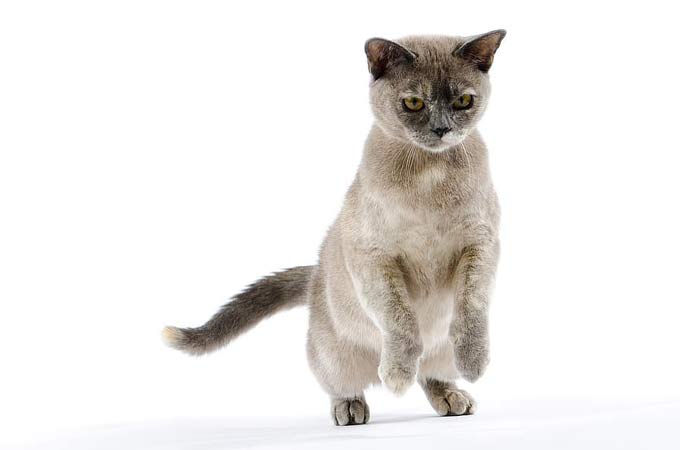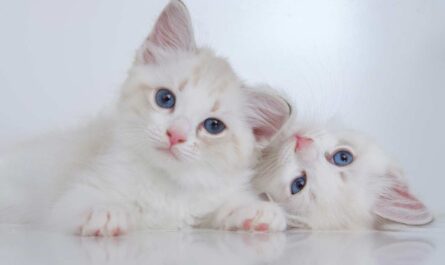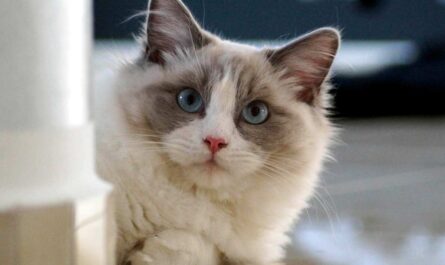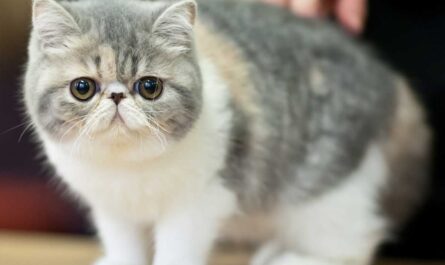Why do cats knead their owners with their paws? You’re curled up on the couch, a good book in hand, and a soft rumble fills the air. It’s not thunder, but the soothing purr of your feline companion. As you stroke their velvety fur, you feel a gentle kneading sensation on your lap – rhythmic little paws pressing and releasing against your leg. This endearing behavior, often accompanied by blissful purring, creates a moment of pure contentment for both the cat and the cat owner.
But have you ever wondered why cats knead their humans with their paws? This article delves into the fascinating world of feline kneading, exploring the origins of this behavior, the various theories behind it, and the potential benefits it holds for both our furry friends and ourselves. We’ll also dispel any misconceptions surrounding this act, revealing the knead-to-know truths about this heartwarming display of feline affection.
A Pawsitive Start: Kneading Behavior in Kittens
Ever witnessed your feline friend rhythmically pushing their paws in and out on a soft surface, rumbling contentedly? This adorable behavior, often referred to as “kneading,” is an instinct carried over from their kittenhood days. But what exactly is the purpose behind this rhythmic pawing? Let’s delve into the fascinating world of feline behavior and explore the two main reasons why kittens knead:
The Milk Machine: Fueling Up with a Built-In Massage
Imagine a tiny kitten nestled against their mother’s warm body, instinctively kneading with their soft paws. This rhythmic motion isn’t just a cute quirk; it serves a vital purpose during a critical time in a kitten’s life. Kittens are born entirely dependent on their mother’s milk for nourishment. The kneading action, applied to their mother’s mammary glands (milk-producing tissue), helps stimulate milk flow. Think of it as a built-in massage, ensuring a steady supply of the essential nutrients needed for growth and development. This behavior is so deeply ingrained that even orphaned kittens, bottle-fed from birth, may exhibit kneading motions on their caretaker’s lap or bedding.
A Comforting Embrace: Kneading as a Security Blanket
Beyond its practical function, kneading also provides a sense of comfort and security for kittens. The act of kneading mimics the sensation of nursing against their mother’s warm body, a time of deep contentment and closeness. This association with comfort and safety can persist into adulthood, making kneading a self-soothing behavior for many cats. Imagine a kitten curled up on a soft blanket, paws gently kneading – it’s a way to recreate that feeling of warmth, love, and security experienced during those early days with their mother.
As you can see, kneading in kittens is a complex behavior with both a practical and an emotional component. It’s a beautiful reminder of the strong bond between mother cats and their kittens and behavior that often continues to bring comfort and joy to felines well into their adult lives.
Beyond the Bottle: Why Adult Cats Knead? Theories and Explanations
Have you ever settled in for a cuddle with your feline friend, only to be met with a rhythmic kneading of their paws on your lap or favorite blanket? This endearing behavior, often accompanied by a rumbling purr, can leave us both charmed and curious. Why exactly do adult cats knead? While the exact reason remains a delightful mystery, several fascinating theories offer a glimpse into the rich inner world of our furry companions.
H3: Scenting Their Domain: The Territorial Marker
One theory suggests that kneading is a way for cats to mark their territory. Cats have scent glands located on their paws, including between their toes and on the pads. When they knead, these glands release pheromones, which are essentially chemical signals cats use to communicate with each other. By kneading on you or your belongings, your cat might be subtly claiming you (and your comfy lap) as their own. Imagine it as a feline way of saying, “This human belongs to me, and this is my favorite napping spot!”
Kneading with Love: A Sign of Affection
Another heartwarming theory suggests that kneading is a sign of affection and contentment. Kittens knead their mother’s stomach to stimulate milk flow while nursing. As adult cats knead on you, it might be a way of showing their love and trust, a throwback to a happy time in their kittenhood. Think of it as a feline hug, a way of expressing, “I feel safe and happy here with you.”
A Self-Soothing Ritual: Kneading for Relaxation
Cats are masters of relaxation, but even they can experience stress or anxiety. Some experts believe that kneading serves as a self-soothing mechanism for adult cats. The rhythmic kneading motion might have a calming effect, similar to how humans might knead dough or fidget with objects when feeling overwhelmed. Imagine it as a feline way of de-stressing, a purrfect way to unwind after a long day of napping and chasing dust bunnies.
A Whisker of Nostalgia: Memories of Kittenhood
Kneading might also trigger happy memories of a cat’s kittenhood. The kneading motion combined with a soft surface might evoke a sense of comfort and nostalgia for the time spent nursing their mother. Think of it as a warm memory lane for your cat, a way of reconnecting with a happy and secure time in their life.
While the exact reason for kneading remains a delightful enigma, understanding these potential explanations can deepen the bond between you and your feline friend. The next time your cat starts kneading on you, take it as a compliment – they might be marking you as their special territory, showering you with affection, self-soothing, or simply reminiscing about happy memories. So, sit back, relax, and enjoy this unique form of feline communication!
A Purrfect Partnership: The Benefits of Kneading for Cats and Owners
Ever witnessed your feline friend rhythmically pressing their paws against your lap, a soft rumble emanating from their throat? This endearing behavior, known as kneading, is a common sight for cat owners. But what exactly is kneading, and why do cats do it? Delving into the reasons behind this purrfectly instinctive behavior reveals a fascinating glimpse into the deep bond between cats and their humans.
Kneading: A Call Back to Kittenhood
Kittens instinctively knead their mother’s stomach while nursing to stimulate milk flow. This behavior not only aids in feeding but also creates a sense of comfort and security for the kitten. As cats mature, they often retain this kneading behavior, even though it’s no longer necessary for sustenance.
Strengthening the Bond: A Massage for the Soul
When your cat kneads you, it can be interpreted as a sign of affection and contentment. The rhythmic kneading motion, often accompanied by gentle head nudges and purring, creates a sense of connection and reinforces the positive bond between you and your feline companion. Think of it as a feline massage – a way for your cat to express their love and trust in you, seeking comfort and familiarity in your presence.
Stress Relief for Cat Owners: A Dose of Kitty Therapy
The rhythmic kneading motion and the soft purring that often accompanies it can have a surprisingly calming effect on humans as well. Studies have shown that interacting with cats, including petting and observing their calming behaviors, can lower blood pressure, reduce stress hormones, and promote feelings of relaxation. So, the next time your cat decides to knead your lap, embrace it as a moment of mutual relaxation – a furry therapist offering a dose of stress relief!
A Sign of a Happy Cat: Contentment Through Kneading
Kneading is generally considered a positive behavior in cats. It indicates that your feline friend feels safe, secure, and content in your presence. The act of kneading can be a self-soothing mechanism for cats, helping them to relieve anxiety and settle into a relaxed state. Therefore, if your cat kneads you, consider it a compliment – a sign that you’ve created a loving and comfortable environment where your cat feels happy and at ease.
Important Note: While kneading is typically a harmless behavior, excessively rough kneading can cause scratches or snags on clothing. If your cat’s kneading becomes too vigorous, gently redirect their paws to a scratching post or a soft toy. Providing an outlet for their kneading instincts can help protect your furniture and clothes while still allowing them to express this natural behavior.
Decoding the Knead: A Purrfectly Normal (But Sometimes Puzzling) Behavior
Have you ever witnessed your feline friend rhythmically kneading your lap with their paws? This endearing behavior, often accompanied by a rumbling purr, can leave cat owners both charmed and curious. But what exactly is your cat trying to communicate through this act of “kneading”? While it’s most commonly associated with contentment and affection, there’s more to the story than meets the eye. Let’s delve deeper into the fascinating world of feline kneading, decode its potential meanings, and address some common misconceptions.
When the Kneading Becomes Excessive
While kneading is a natural feline behavior, sometimes it can become excessive. If your cat seems to be kneading constantly, with unusual intensity, or on objects other than your lap, it might be a sign of an underlying issue. Here are some potential reasons for excessive kneading:
- Anxiety or Discomfort: Cats can knead as a way to self-soothe and manage anxiety. If your cat has experienced a change in their environment, new pet introductions, or loud noises, excessive kneading could be a sign of stress.
- Medical Conditions: In some cases, excessive kneading might be linked to medical conditions like arthritis or discomfort in the paws. If you’re concerned about your cat’s kneading behavior, a visit to the veterinarian can help rule out any underlying health issues.
Remember: If your cat’s kneading habits seem unusual or excessive, consult a veterinarian to ensure their well-being.
Beyond Affection: Kneading as Communication
While kneading is often interpreted as a sign of affection, it’s important to remember that feline communication is nuanced. Here are some other reasons why your cat might be kneading:
- Seeking Attention: Sometimes, kneading can be your cat’s way of getting your attention. If you respond with petting or playtime after they knead, they might learn to associate this behavior with positive reinforcement.
- Marking Territory: Cats have scent glands in their paws. Kneading on furniture or your lap might be their way of marking their territory and feeling secure in their environment.
- Habitual Behavior: Kittens knead their mothers to stimulate milk production. Some cats carry this behavior into adulthood simply out of habit or comfort.
Understanding the context surrounding your cat’s kneading behavior can help you decipher its true meaning. Are they purring contentedly? Do they seem anxious or stressed? Paying attention to these cues will provide valuable insights into your feline friend’s emotional state.
Claws vs. Kneading: Debunking the Myth
A common misconception is that cats knead to sharpen their claws. However, these are two distinct behaviors with different purposes. Kneading involves a gentle pressing motion with the paws while scratching uses a more extended claw extension and retraction on a rough surface. So, the next time your cat kneads on your lap, rest assured that their claws are most likely retracted and not a cause for concern.
Remember: Providing your cat with scratching posts can help them fulfill their natural scratching instinct and prevent them from damaging furniture.
By understanding the different reasons behind kneading, you can develop a stronger bond with your feline companion. So next time your cat starts their rhythmic kneading routine, appreciate this unique form of feline communication and enjoy the moment of connection it brings.

Living with a Kneader: Tips for Managing Pawsitive Interactions
Ever curled up on the couch with your feline friend, only to have them rhythmically push their paws against your lap? This endearing, yet sometimes furniture-threatening, behavior is known as kneading. While it might leave you wondering if you’ve accidentally become a giant cat bed, there’s more to this instinct than meets the eye! Let’s delve into the fascinating reasons behind kneading and explore ways to ensure these pawsitive interactions bring joy to both you and your furry companion.
Channeling Inner Kittenhood: Providing Alternatives for Kneading
Kneading often evokes nostalgic memories for cat owners, as it mimics the way kittens massage their mother’s stomach to stimulate milk production. This behavior can persist into adulthood, offering your cat a sense of comfort and security. However, if your cat’s kneading becomes destructive to furniture, here are some tips for providing alternative outlets:
-
Scratching Posts Galore: Cats have a natural instinct to scratch, and providing them with ample scratching posts can redirect their kneading energy. Choose scratching posts in various textures (sisal, cardboard) and heights to cater to your cat’s preferences. Place them in strategic locations, like near their favorite napping spots or by doorways, to encourage scratching.
-
Catnip Magic: Sprinkle a little catnip on a scratching post or cardboard scratcher. The enticing scent of catnip can pique your cat’s interest and encourage them to use the designated scratching surface instead of your furniture.
-
DIY Cardboard Delights: For the crafty cat owner, creating DIY cardboard scratchers is a budget-friendly option. Use sturdy cardboard boxes and cut out scratching surfaces. You can even get creative and add different textures by gluing on sisal rope or carpet scraps. Rotate a few cardboard scratchers to keep things interesting for your feline friend.
By providing these alternatives, you’re offering your cat a more appropriate outlet for their kneading needs, saving your furniture from potential snags and tears.
Positive Reinforcement: Rewarding Gentle Kneading
Some cat owners find that gentle kneading can be a rather endearing behavior. If your cat keeps their kneading on your lap relatively tame, consider using positive reinforcement to encourage this gentler version. Here’s how:
-
A Gentle Stroke: While your cat is kneading softly, offer them a gentle stroke or scratch behind the ears. This positive association can help them understand that gentle kneading is an acceptable way to interact with you.
-
Praise and Treats: When your cat displays gentle kneading behavior, offer them verbal praise (“Good kitty!”) or a small treat. This positive reinforcement can strengthen the association between gentle kneading and a desired outcome.
Remember: It’s important to be consistent with your rewards. Only offer praise or treats when your cat exhibits the desired gentle kneading behavior.
Respecting Boundaries: Disengaging When Necessary
While kneading is generally a harmless behavior, some cats might become overly enthusiastic or aggressive while kneading. In such instances, it’s crucial to respect your cat’s boundaries and gently disengage. Here’s how to handle the situation calmly:
-
A Gentle Move: Without jerking your hand away, slowly and calmly move your cat to a designated scratching post or another appropriate outlet for their kneading energy.
-
Change in Scenery: If your cat becomes overly enthusiastic while kneading your lap, you can gently pick them up and place them on the floor. This provides a clear signal that playtime is over, and they can redirect their energy elsewhere.
Remember: Punishing your cat for kneading is not only ineffective but can also damage your bond. Focus on providing alternatives and positive reinforcement for desired behaviors.
By understanding the reasons behind kneading and implementing these tips, you can ensure these pawsitive interactions strengthen the loving connection between you and your feline companion. So next time your cat starts kneading, remember, it’s just their way of showing affection (and maybe a subconscious request for a milk bar!).
The Science of the Purr: Unveiling the Mystery of Kneading
The rhythmic kneading motion displayed by our feline companions continues to baffle and endear us in equal measure. While science has shed light on some of the potential reasons behind this behavior, there’s still much to discover. This section delves into the exciting realm of ongoing research, exploring the emotional connection between kneading and cat behavior, and the fascinating role of pheromones in feline communication.
Decoding the Emotional Knead: A Look at Ongoing Research
Cat owners can attest to the feeling of contentment and affection that often accompanies a kneading session. But what’s happening from a scientific standpoint? Researchers are actively investigating the emotional connection between kneading and cat behavior. Here are some intriguing possibilities:
- Memories of Kittenhood: One theory suggests that kneading evokes positive memories from a cat’s kittenhood. The act of kneading on their mother’s stomach stimulated milk production, and it may now trigger feelings of comfort and security in adult cats.
- A Sign of Contentment: Many cat owners observe kneading during moments of relaxation and purring. This could indicate that kneading is a self-soothing behavior, a way for cats to express happiness and contentment.
- Marking Their Territory: Cats have scent glands on their paws, and kneading might be a way of depositing their scent on a favorite blanket, human lap, or piece of furniture. This act of marking their territory reinforces a sense of security and ownership for them.
While these are just some of the ongoing theories, further research is needed to definitively understand the emotional significance of kneading in cats. However, one thing is certain – observing this behavior can provide valuable insights into a cat’s emotional state and strengthen the bond between feline and human companion.
The Scent of Connection: The Intriguing Role of Pheromones
Pheromones are chemical messengers released by animals that can influence the behavior of others. Interestingly, cats have scent glands located between their toes. The theory goes that when a cat kneads, these glands release pheromones that communicate with other cats or even their human companions. Business – Money Making – Marketing – E-commerce
- Feline Communication: Pheromones released during kneading might signal comfort and safety to other cats in the household. This could be a way of establishing a sense of camaraderie and social cohesion within a feline multi-cat family.
- Bonding with Humans: While the science is still in its early stages, some researchers believe that pheromones released during kneading might also influence human behavior. These pheromones could trigger feelings of relaxation and affection in cat owners, further strengthening the human-feline bond.
The potential role of pheromones in kneading behavior adds another layer of complexity to this fascinating feline habit. Future research in this area could provide groundbreaking insights into cat-human communication and shed light on the powerful emotional connection we share with our furry companions.
Final thought: A Knead-to-Know Phenomenon: A Celebration of Mystery and a Unique Bond
The world of feline behavior is an ever-evolving puzzle, and the exact reasons behind kneading remain somewhat shrouded in mystery. This, however, only adds to the charm of this endearing act. The rhythmic kneading of a contented cat offers a glimpse into their complex emotional landscape, a nonverbal expression of comfort, security, and perhaps even a flicker of nostalgia for their kittenhood. Cat accessories on Amazon
Whether it’s a subconscious echo of nursing behavior, a way of marking territory, or simply a feline form of kneading dough (because, let’s face it, cats can be pretty darn curious!), this behavior strengthens the unique bond between these fascinating creatures and their human companions. So, the next time your cat graces your lap with their kneading paws, embrace the moment. It’s a purrfect display of feline affection, a heartwarming reminder of the special connection we share with these captivating companions.
Other Interesting Articles
- How to Help Your Cat Overcome Fears in 13 Strategic Steps
- 13 Easy Tricks To Teach Your Cat: Basic Feline Training Guide
- How To Train Your Cat: 15 Easy Steps To Teach New Things
- Why Do Cats Have Tails? 4 Fun Facts You Didn’t Know
- 16 Simple Ways To Establish A Stronger Bond With Your Cat
- How To Train Your Cat/Kitten To Sit: Steps, Command, Guide
- Cat Giving Birth: From Your Feline Pregnancy to Kitten Care
- Fading Kitten Syndrome: Age, Causes, Symptoms, Treatment
- Kitten Bottle Feeding: Chart, Tips, Recipe, Challenges, Guide
- Cat Pregnancy: Timeline, Signs, Labor, Behavior, Stages
- 16 Silent Killers of Cats Every Pet Owner Must Be Aware Of
- Do Mother Cats Discipline Their Kittens? A Guide To Owners
- How To Take Care of A Kitten 6 Weeks Old: A 7-Step Guide
- How To Tell If Your Cat is Trying to Hurt You: A To-Do Guide
- How To Tell If Your Cat Has Tapeworms: What You Can Do
- How To Tell If My Cat is in Pain After Neutering: What To Do
- How To Get A Cat To Trust You Fast: Signs, Tips, Techniques
- 12 Signs Your Cat is a Boy: Tips To Distinguish A Male Cat
- Single Kitten Syndrome: Age, Signs, Symptoms, Treatments
- How To Tell If Your Cat Can’t See Well: What You Can Do



